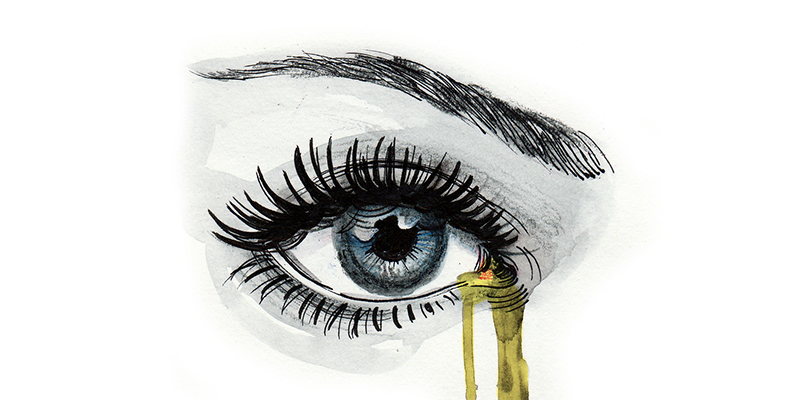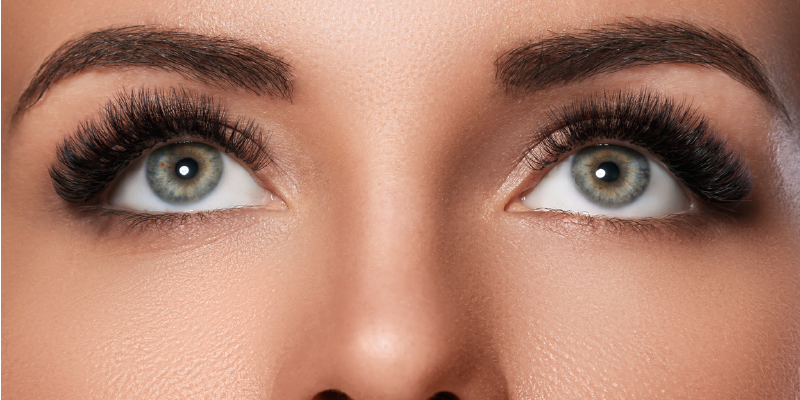Eye mucus, like any other discharge, is an icky subject, being given less-than-charming nicknames like “eye gunk” or “eye boogers.” Eye mucus is a sticky, yellow substance that collects in the corner of your eyes or along your eyelashes. A low level of eye discharge is normal, but higher amounts can be irritating and indicate a problem in your eye. So, what are the signs that something is wrong, and what exactly do they mean?
Normal eye mucus is a combination of a watery film called rheum, oil, skin cells, and other debris that accumulates in your eye. Typically, this is cleared away by your natural tear production and blinking during the day. At night, when you are not blinking, this mucus tends to collect in the corners of the eyes, resulting in the “sleep in your eyes” or “sleepy bugs” that are commonly found in the morning after waking up. They can be wet and sticky or dry and crusty depending on how much moisture has evaporated, and can usually be cleared easily by wiping a finger across the corner of the eye or by gently washing with a dampened cloth.1,2
Greater amounts of mucus than your typical morning accumulation, however, are a sign that there may be a problem with your eye, especially if it is causing discomfort or sticking your eyelashes together. Blurry vision, light sensitivity, or pain accompanying this discharge especially are indicators of an infection or other disorder.
Causes of Excessive Eye Mucus
A common cause of excess eye mucus is conjunctivitis, also known as pink eye. This is caused by inflammation of the conjunctiva, the glands that produce the rheum fluid in your eyes, and is typically due to either a viral or bacterial infection. Other symptoms of conjunctivitis are sore or itchy eyes, and the characteristic red veins that give eyes their pink appearance from a distance. Dacryocystitis, inflammation of the tear ducts in the inner corners of the eyes, is another possibility, and is caused by an infection in the tear duct.
Another cause of extra eye mucus is blepharitis, or inflammation of the eyelid. Blepharitis may be caused by many conditions, including bacterial or viral infections, blockages in the meibomian glands, which produce a protective lipid layer over the eyes, and infestation with Demodex mites. Demodex mites, also known as eyelash mites, are actually present in most people, but can trigger eye irritations and disorders when they become overpopulated.
Finally, allergies and reactions to environmental factors such as pollutants, makeup, or contact lenses may be causing extra mucus production as these can cause your eye to increase its natural means of removing irritants.
Proper Eye Hygiene Can Help
If you have a new or sudden increase in eye mucus, it is recommended that you visit your eye doctor to get checked out for infections or Demodex infestation. Proper ocular hygiene also will help tremendously with clearing or preventing excessive eye mucus. Using a facial cleanser such as Cliradex Light or eye wipes such as Cliradex Towelettes will keep irritants out of your eyes, help reduce inflammation, and help resolve tough-to-clear Demodex infestations. In the case of more advanced bacterial infections, your doctor may prescribe antibiotics.
Resources:
1. Prabhasawat P, Tseng SC. Frequent association of delayed tear clearance in ocular irritation. The British journal of ophthalmology. 1998;82(6):666-675.
2. Schneider T, Stokholm J. Accumulation of fibers in the eyes of workers handling man-made mineral fiber products. Scandinavian journal of work, environment & health. 1981;7(4):271-276.
Infographic:
| Bacteria→
Virus→ Demodex mites→ Allergens→ Pollutants→ Irritants→ |
Conjunctivitis→
Blepharitis→ Dacryocystosis→ Dry eye→ |
Excessive eye mucus |





